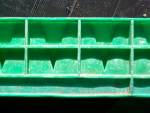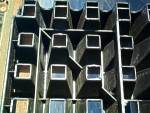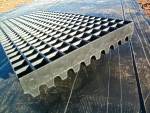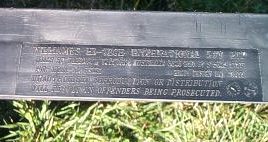Start with the seed
Using the right seed is fundamental to growing a good seedling. The
seed you use will determine your germination, influence the speed and accuracy with which
you can sow, and may also influence the rate of growth of the seed and its resistance to
disease. Seed is a living thing, and is influenced by many factors. Growing a good
seedling involves appreciating the complexity of seed as a living organism while providing
the best possible conditions for the seed to germinate and grow.
Seed can be purchased as either raw seed, film coated seed or
pelleted seed, or you may collect your own seed. Many of the seed companies will coat or
pelletise your raw seed.
Raw seed has no coating, and is the lowest cost of all seed. However
raw seed may be shaped in a way that makes machine seeding into a cell tray difficult - it
may hairy, be very pointy or very flat. This may mean that some cells in the tray have no
seed sown into them, others may have doubles or multiples of seed.
Film coated seed has a thin film of chemicals - usually a fungicide
- plus perhaps micronutrients, and a colour additive. This thin film will take the edges
off the shape of the seed and make it easier to sow. Film coated seed is not widely used.
Pelleted seed completely disguises the size and shape of the
original seed, pelleted seed is usually round and very easy to sow. The coating will
usually have a fungicide, sometimes micronutrients and colouring, and will largely consist
of clay to give the round shape. Vegetables seeds are often coated, and colours can be
used to distinguish different varieties. The clay coating dissolves when the seedling is
watered enabling the seed to germinate.
Seeds can also be primed to improve the uniformity and speed of
germination. Priming is a process where the seeds are bought closer to the point of
germination, and its effectiveness varies between crop types. Capsicum seeds, for example,
respond well to priming.
When deciding which seed to use the following should be considered:
- Raw seed is the cheapest, but where the seed is hairy, very pointy or
an odd shape making it difficult to seed the cost savings may be lost due to the increased
expense of seeding or inaccuracies in seed placement while seeding. This may reduce the
number of good seedlings.
- Pelleted seed enables very high speed rotary drum seeding at high
levels of accuracy. A pelleted seed with a high germination if used with a rotary drum
seeder will result in very good results in the tray, with almost all cells having one
germinated seedling in them.
- For needle row seeding, which is much slower than rotary drum
seeding, the vibrating seed hopper may cause dust problems when using pelleted seed and
reduce the accuracy of seeding.
- For any sort of mechanical seeding uniformity of seed size is
important for accuracy, it may be necessary to grade your seed to get optimum seeder
performance.
- The fungicides incorporated in a seed’s pellet may be very
beneficial in reducing disease during the emergence stage of the seedling’s growth. A
fungicide treated seed will often save the need to later treat your seedlings, and is a
more effective, less wasteful use of chemicals.
No matter what seed type you choose, to get the best results from
your seed:
- Store it at the right temperature. This depends on the seed type,
your seed supplier will be able to advise.
- Keep seed tin lids closed and packets sealed. Humidity has a great
effect on the life and viability of your seed.
- Read the information on the seed packet. This will tell you what
germination you can expect, the date when the seed was tested for its germination, its
expiry date and other information. Some seeds have a low shelf life and need to be sown
virtually straight away.
- Keep records which track the seeds from the seed packet through the
nursery. This may alert you to problems with the seed.
The germination percentages as specified on the seed packet need to
be interpreted with care. Temperature in particular has a large effect on germination, and
for many seed types germination may vary widely depending on temperature. Your seed
supplier should be able to advise. Where you expect to use large quantities of one seed
type/variety getting accurate information on the optimum temperature to achieve maximum
germination may result in savings of thousands of dollars.
Having started with the seed, giving it a healthy environment to
grow in is the next concern.
Use the
right mix

Seeds need a mix with plenty of the right nutrients, good moisture
holding capacity, which has good porosity for air circulation, with no large clods, the
right density and which flows easily when filling trays.
Many large nurseries will have their own secret blend which they
fiercely protect. The type of mix used also depends a great deal on the availability of
raw materials - for example in New Zealand a lot of pumice is used. In general however most
mixes have 2 components: a nutrient rich base (eg peat moss) and a "mulch" to
promote aeration and water retention such as vermiculite. Where a heavier mix is required
sand or decomposed bark may be added. More nurseries are now moving towards the addition
of a fertiliser in the mix.
Williames Hi-Tech International make mixers ranging from 0.5 cubic
meters (3/4 of a cubic yard) up to 3 cubic meters (4 cubic yards). Our mixers are used
both by companies which professionally prepare and supply mixes and in the nursery, where
in most cases they feed straight into the tray filler. Mixing just before you fill and sow
your trays keeps the mix fresh, fertilisers will have had no time to leach out, and you
have greater control over the mixing. Williames' mixers use double helix ribbons for
gentle yet fast mixing. Click here to learn more about the
Williames' mixers which help
you grow better plants.
Properly
fill your trays

Getting a good complete fill in the trays is essential for a good
plants to grow. In particular you want:
- An even fill in each cell of the tray
- A complete fill in each cell of the tray.
An uneven fill across the tray may often result in uneven growth. A
fill which is too soft may mean that the plant doesn't have much to grow on, and may stunt
growth. And when it comes to transplanting, there is nothing worse for transplanting
machines than a transplant without a good strong root mass, which needs a good fill to
develop properly.
A good fill will:
- Aid in vigorous and even plant growth.
- Make transplanting easier
- Assist in uniform growth in the field and a bigger harvest.
With a trend towards ever more deeper trays, getting a good hard
fill right down to the tip of the cell is very important. Williames makes 2 models of tray
fillers, both of which give good control over the density of fill. Click here to learn
more about the Williames' fillers which help you grow better plants.
Use the
right tray

The seedling cell tray you use can have a profound effect on the
quality of your seedlings and the viability of your business. A tray contributes to:
- The density of plants, and thus the operating costs, in your nursery
- The quality of the root structure of the plug, which in turn effects
the quality of harvest.
- The suitability of the seedling to transplanting
- The survival rate of your transplants in the field.
From a growing perspective its all about cell shape. From a business
perspective, the cost, durability, plant density, ease of cleaning, ease of handling and
suitability to automatic transplanting are all important.
Cell shape
Unfortunately many nurseries have trays with sub-optimum cell shapes. Some of the problems
arising from poor cell shapes are shown below.
To grow the best transplant you don't want:
- You don't want spiralling roots, which
don't "take" as well when the seedling is transplanted, diminishing the vigour
of the plant and increasing the likelihood it will be blown over in a strong wind.
|

|
|
|
|

|

|
- You don't want a square shaped cell which takes up a lot more area in your nursery for the same
cell volume as a deeper, narrower cell. Square cells mean you get less plants in your greenhouse and spend more per cell on heating, watering and fertilising.
|

|

|
- You don't want the transplant to stick in the tray when you go to pull it. Expanded polystyrene trays are notorious for roots growing into the cell walls.
This means that the root is ripped off when the plug is pulled, damaging the seedling and
also making it hard to clean the tray. Styrene trays are also notoriously hard to clean,
and can carry disease with them.
|

|

|
- You don't want cell walls that come in a lot towards a
narrow bottom. This means that the roots don't have much room to grow out into, diminishing the
vigour of the
seedling. Plugs from a tray with a small bottom are also hard to mechanically transplant.
Since the base of the plug is so small when the plug falls into the kicker its tip may be
squashed, making it hard to transplant at an even height.
|

|

|
To grow good transplants you need a good cell like the one shown below:
This cell, from the Williames 240 cell tray, has the following features which enable
excellent transplants to be grown in it:
- Sharp inside corners and a large open bottom, which prevent root spiralling.
- A large, open bottom for good aerial pruning of the roots
- A fairly deep cell, so you get more plants in your nursery. Compared with the Australian 198 cell tray,
the 240 cell has exactly the same soil volume but you get 20% more plants into the same sized tray.
- A rough inside texture, which helps stop water and fertiliser running out down the sides and promotes aeration.
However the texture is not so rough that the plugs are hard to pull.
Research in Holland and in California is also showing the importance
of having a deep, reasonably narrow cell, which helps develop a thicker calliper
on the
stem. The photo below shows such a cell, from the Williames 224 cell tray - look at the
stems of those plants!
Look at the
THICK stems of those plants!
|
A tray will make good business sense: |
If it helps you get more plants in the nursery. There are limits to
how small a plug you can go, and in California nurseries are pushing the limits much more
than in Australia. In Australia in particular nurseries are using plugs which take up more
area than they need to. A Williames 240 cell tray straight away gives 20% more plants in
the same area as a 198 cell tray, with no cost to plant quality, viability or suitability
to transplanting!
|
|
If it is easy to clean. Styrene trays and cells with
undercuts along the side like the one shown in this picture aren't.
|
 |
| If it has a long life. Your investment pays
for itself many time over as compared to a cheaper tray which doesn't last as long. |
If it is strong, and can take a bit of punishment.
Many Williames trays incorporate a diagonal brace to help stop the corners breaking out,
as shown in the 240 cell tray.
|

|
If they are suited to automatic transplanting. Williames trays have a
patented built in gear rack suited to automatic transplanting.
|
 |
|
With labour costs going up automatic transplanting is here to stay. |
Williames has a range of high quality trays to suit the T rails,
bins and stillages used in every major vegetable growing region in the world. Williames
also protects its customers with patents on its trays, and will prosecute infringement of
these patents.
If you use a Williames tray you have a competitive advantage, and
we want to protect this for you!
Click here to learn more about the
Williames' range of trays which
help you grow better plants.
Sow your seeds at the
right depth, with good accuracy.

Every seed you sow has the potential to grow into a
healthy vigorous plant. However, for that potential to be realised, the seed has to be
placed at precisely the correct depth, in the centre of the cell, and with a minimum
number of undesired doubles or misses.
|
Place some seeds too deep - and the seed spends most of its energy
just getting the radical to the surface, some seeds don’t make it at all |

|

|
|
Place a seed on the edge or corner of a cell and it can dry out and
not germinate. If it grows its roots grow unevenly |

|

|
|
Place a seed in the centre
at the right depth and the seed has ideal conditions for growing into a
strong healthy seedling. Williames timed dibber and seed drums get the
seed in the right place |

|

|
|
Place more than one seed in a cell (unless on purpose - eg shallots)
and the nutrients in the cell are split between two or more plants. When excess plants are
pricked out the roots of the remaining seedling are often damaged, stunting growth in the
future due to transplant shock |

|

|
|
Miss planting a seed in a cell - and nothing grows, even with the
best possible care of the tray after seeding. If say only 3% to 5% more live plants are
grown this represents pure profit of 3% to 5% of total turnover as profit as all capital
cost, soil, glass house space, heating and labour etc. is already covered
|

|

|
The accurate placement of seed in the centre of the cell at the
right depth is one of the critical factors for the development of a healthy plant and, as
discussed above, the seed type - whether raw, film coated or pelleted will greatly
influence the accuracy of seeding.
Williames seeders give you full control over the
depth of placement (it’s simple as well - just wind a handle up or down) and the
conveyor, dibber and seed drum are mechanically connected and timed to give very accurate
seed placement. By having at least 3 singulator bars (optionally 5) blowing in different
directions to remove any doubles or multiple seeds you have high control over how many
seeds go into each cell. The Williames rotary drum seeders enable you to give your seeds
the best possible start.
Click here to learn more about the
Williames' seeders which help you
grow better plants.
Keep the moisture levels right.

During the critical period when a seed germinates it is vital that
the young plant has enough water to keep on going. For this reason trays are often covered
with vermiculite - which helps retain moisture - and are watered straight after sowing.
Giving the trays a good soak after seeding is particularly important
when pelleted seed is used, as the water helps break down the clay coating around the
seed.
Williames manufacturers Vermiculite coverers and watering tunnels
which help keep the moisture levels right at that critical time when the seed is
germinating. Click on the following links to learn more about the
Williames' coverers and
watering tunnels
which help you grow better plants.
For the seedling in the greenhouse, getting an even quantity of
moisture to each seedling is important for even growth. Boom irrigation systems give a
much more even cover than sprinklers or hand watering.
Use a
germination room

Getting a high rate of germination and even emergence is one thing
that leading nurseries seem to excel at, and a germination room plays a key role in this.
Seed, as a living organism, is often highly influenced by temperature. A germination room
enables the nursery to maintain the trays it has just sown at the right temperature levels
for maximum germination.
Walk your
nursery

"What are a bunch of machinery manufacturers doing telling me
to walk my nursery. Of course I do!"
Harden off

A hard plant may be harder to grow than a soft plant, but when it
comes to transplanting it can make a big difference. Hard plants
- Survive the shock of transplanting better, and have higher survival
rates
- Can give more uniform yields.
- Save you money.
A plant which has been kept out from under the protection of glass
or shade has to harden up to survive. As soon as the plant is moved outside you are saving
on heating and other costs inside your greenhouse.
In particular for automatic transplanting, which can have multiple
benefits to the grower, a hard plant is important to be able to survive the forces the
seedling is subject to as it is rapidly moved out of the tray and into the ground.
In particular if you want your seedlings to be transplanted
successfully pay attention to developing a hard root structure and a good strong stem.
Having a good fill and using a good cell shape help you achieve this.
Keep
your nursery clean

Disease in your nursery can have devastating effects. Keeping your
nursery clean will help prevent disease, and making sure that everthing that comes into
your nursery is disease free is important as well. Watch for:
- Seed. Make sure your seed is disease free. If you are unsure where it
came from there are a number of treatments available, including acid treatment, hot water
treatment and fungicide dusting.
- Mix. You may have to sterilise on site if you are unsure of its
origin.
- People coming into the nursery. Some nurseries have a foot dip which
people have to walk through to get into the nursery.
For further advice on vegetable disease we recommend consulting the
Australian Vegetable Growers Handbook, published by Scope Publishing, 20 Sundown Walk,
Frankston, Vic 3199; call Nel Snaidero Tel 02 6960 1550 for sales.
Measure
your results

Growing a good transplant requires a great deal of skill, and
judgement, and most good nursery managers are always experimenting with something to
improve their results. Without tracking seedlings through the nursery and ideally through
the field to harvest its difficult to precisely identify both causes for problems and
reasons for success.
Williames is working towards developing data collection systems to
assist nurseries with tracking their seedlings through their nurseries and grow better
seedlings - for more information please contact us.
Copyrightę 1999,2000 Williames Hi-Tech
International Pty Ltd
|






